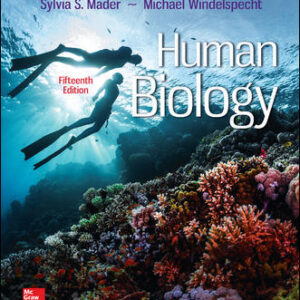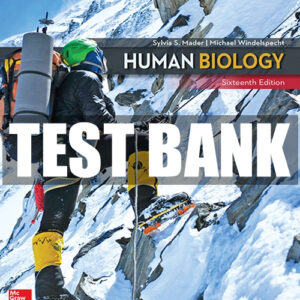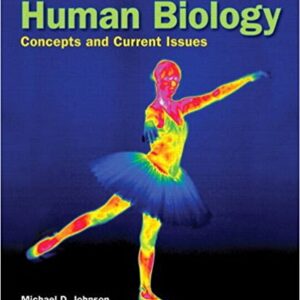Test bank for Campbell Biology 11th Edition
Chapter 1 Evolution, the Themes of Biology, and Scientific Inquiry
1.1 Multiple-Choice Questions
1) Cells are ________.
A) only found in pairs, because single cells cannot exist independently
B) limited in size to 200 and 500 micrometers in diameter
C) characteristic of eukaryotic but not prokaryotic organisms
D) characteristic of prokaryotic and eukaryotic organisms
Answer: D
Bloom’s Taxonomy: Knowledge/Comprehension
Section: 1.1
2) In comparison to eukaryotes, prokaryotes ________.
A) are more structurally complex
B) are larger
C) are smaller
D) do not have membranes
Answer: C
Bloom’s Taxonomy: Knowledge/Comprehension
Section: 1.1
3) Which of the following types of cells utilize deoxyribonucleic acid (DNA) as their genetic
material but do not have their DNA encased within a nuclear envelope?
A) animal
B) plant
C) archaean
D) fungi
Answer: C
Bloom’s Taxonomy: Application/Analysis
Section: 1.1
4) To understand the chemical basis of inheritance, we must understand the molecular structure
of DNA. This is an example of the application of which concept to the study of biology?
A) evolution
B) emergent properties
C) reductionism
D) feedback regulation
Answer: C
Bloom’s Taxonomy: Application/Analysis
Section: 1.12
5) A localized group of organisms that belong to the same species is called a ________.
A) community
B) population
C) ecosystem
D) family
Answer: B
Bloom’s Taxonomy: Knowledge/Comprehension
Section: 1.1
6) Which of the following statements is true regarding the complexity of biological systems?
A) An understanding of the interactions between different components within a living system is
an approach towards understanding reductionism.
B) Knowing the function of a component of a living system can provide insights into the
structure and organization of the living system.
C) Understanding the chemical structure of DNA reveals how it directs the functioning of a
living cell.
D) An ecosystem displays complex properties of the biotic component only.
Answer: B
Bloom’s Taxonomy: Application/Analysis
Section: 1.1
7) Which of the following order is correct in terms of the hierarchy of the organization?
A) Ecosystem → Biosphere → Population → Community → Organism
B) Biosphere → Ecosystem → Population → Community → Organism
C) Ecosystem → Community → Biosphere → Population → Organism
D) Biosphere → Ecosystem →Community → Population → Organism
Answer: D
Bloom’s Taxonomy: Application/Analysis
Section: 1.1
8) When your body temperature rises on a hot day, the neural and hormonal mechanisms activate
sweating. Evaporation of sweat leads to cooling of the body surface. This is an example of
________.
A) positive feedback regulation
B) negative feedback regulation
C) chemical cycling
D) emergent properties
Answer: B
Bloom’s Taxonomy: Application/Analysis
Section: 1.13
Copyright © 2017 Pearson Education, Inc.
9) Characters are transmitted from parents to offspring. ________ are the units of inheritance.
A) Genes
B) Proteins
C) RNA
D) DNA
Answer: A
Bloom’s Taxonomy: Knowledge/Comprehension
Section: 1.1
10) As letters are to English language, ________ is/are to genetic information.
A) proteins
B) nucleotides
C) DNA double helix
D) A and B
Answer: B
Bloom’s Taxonomy: Knowledge/Comprehension
Section: 1.1
11) The process by which the information in a gene directs the synthesis of a protein is called
________.
A) gene expression
B) replication
C) post translation modification
D) cloning
Answer: A
Bloom’s Taxonomy: Application/Analysis
Section: 1.2
12) Which of the following statements is true?
A) mRNA is the only type of RNA found in the living system
B) All forms of life employ the same genetic code
C) A typical human liver cell has one set of chromosomes
D) Organisms interact but do not affect their environment
Answer: B
Bloom’s Taxonomy: Knowledge/Comprehension
Section: 1.2
13) Plants convert ________.
A) chemical energy to mechanical energy.
B) sunlight to mechanical energy.
C) sunlight to chemical energy.
D) mechanical energy to chemical energy.
Answer: C
Bloom’s Taxonomy: Knowledge/Comprehension
Section: 1.24
Copyright © 2017 Pearson Education, Inc.
14) Which of these provides evidence of the common ancestry of all life?
A) near universality of the genetic code
B) structure of the nucleus
C) structure of cilia
D) structure of chloroplasts
Answer: A
Bloom’s Taxonomy: Application/Analysis
Section: 1.2
15) Which branch of biology is concerned with the naming and classifying of organisms?
A) informatics
B) taxonomy
C) genomics
D) evolution
Answer: B
Bloom’s Taxonomy: Knowledge/Comprehension
Section: 1.2
16) Use the following figure to answer the question.
The phylogenetic tree ________.
A) depicts that Archaea is closer to Bacteria than Eukarya
B) depicts that Eukarya is closer to Bacteria than Archaea
C) includes unicellular and some forms of multicellular life, but not complex animals and plants
D) includes every single life form on this earth
Answer: D
Bloom’s Taxonomy: Application/Analysis
Section: 1.25
17) Use the following figure to answer the question.
“A” is ________; “B” is ________.
A) the most recent species to evolve on Earth; an ancestor of group “A”
B) the most recent species to evolve on Earth; the last common ancestor of Archaea and Eukarya
C) the common ancestor of all life; the common ancestor of Bacteria and Archaea
D) the common ancestor of all life; the last common ancestor of Archaea and Eukarya
Answer: D
Bloom’s Taxonomy: Application/Analysis
Section: 1.2
18) You are suffering from Streptococcus throat infection. You share the following with the
bacteria that is responsible for your condition.
A) You both belong to the same domain.
B) You both are made up of cells.
C) You both have genetic material in your nucleus.
D) You and Streptococcus have nothing in common.
Answer: B
Bloom’s Taxonomy: Application/Analysis
Section: 1.2
19) Which of the following is true of natural selection?
A) It requires genetic variation.
B) It results in descent with modification.
C) It involves differential reproductive success.
D) It requires genetic variation, results in descent with modification, and involves differential
reproductive success.
Answer: D
Bloom’s Taxonomy: Knowledge/Comprehension
Section: 1.2
20) Which of the following is not one of Charles Darwin’s observations?
A) Individuals in a population vary in their traits.
B) Many of the traits in an individual are heritable.
C) A population avoids competition by producing only as many offspring as can successfully
reproduce on their own.
D) Species generally are adapted to their environments.
Answer: C
Bloom’s Taxonomy: Knowledge/Comprehension
Section: 1.26
21) The evolution of one species into two or more species as a result of different populations
becoming reproductively isolated from each other is best termed as ________.
A) adaptive radiation
B) creationism
C) natural selection
D) prototype
Answer: A
Bloom’s Taxonomy: Knowledge/Comprehension
Section: 1.2
22) Cotton-topped tamarins are small primates with tufts of long white hair on their heads. While
studying these creatures, you notice that males with longer hair get more opportunities to mate
and father more offspring. To test the hypothesis that having longer hair is adaptive in these
males, you should ________.
A) test whether other traits in these males are also adaptive
B) look for evidence of hair in ancestors of tamarins
C) determine if hair length is heritable
D) test whether males with shaved heads are still able to mate
Answer: C
Bloom’s Taxonomy: Application/Analysis
Section: 1.2
23) Following a scientific method, which of the following is the correct order of steps?
A) Observation → Analysis → Hypothesis → Conclusion → Communicate results →
Experiment
B) Observation → Hypothesis → Experiment → Communicate results → Analysis →
Conclusion
C) Experiment → Hypothesis → Observation → Analysis → Conclusion → Communicate
results
D) Observation → Hypothesis → Experiment → Analysis → Conclusion → Communicate
results
Answer: D
Bloom’s Taxonomy: Knowledge/Comprehension
Section: 1.3
24) Which of the following questions is considered a thought-provoking scientific query?
A) How long ago did the Pterosaurs live on this planet?
B) Does the amount of solute in water affect the boiling point of the solution?
C) Who invented the telescope?
D) How many tigers are left in India?
Answer: D




